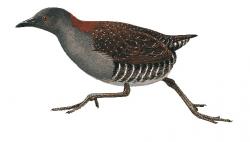As a species, the eastern black rail (Laterallus jamaicensis) tops the list for avid bird-lovers the world over who are eager to catch a glimpse of this reclusive, secretive little creature. That’s because most birders have never actually seen one in the flesh. And most of them never will. In just a few short years the night calls of the eastern black rail have gone silent in many coastal states. In Virginia, for instance, there have been no recorded sightings in two years. Its historic range runs from coastal Massachusetts to Texas and inland to the eastern slope of the Appalachian Mountains. It breeds in tidal and freshwater marshes. Population numbers have always been spotty, compiled piecemeal from a century of literature, museum specimens and unpublished observations. It wasn’t even recognized as a North American bird by the ornithological community until one was captured on a Pennsylvania farm in 1836. From then until 2016, there were 1,937 occurrence records. Outside the U.S., the eastern black rail is also found in Central America and the Caribbean Basin. A combined estimate of its wider population runs between 25,000 and 100,000 individual birds. The soft estimate of its Atlantic coastal population within a recent study area ranges between 455 and 1,315 breeding pairs. In Virginia, the birds were found historically throughout coastal areas from Back Bay in Virginia Beach to Accomack and Northampton counties on the Eastern Shore. When they migrated through in the spring and fall, they could be found along Mobjack Bay on the Middle Peninsula and Grandview Beach in Hampton. Up until modern times, the biggest concentration in Virginia was in Saxis Marsh along the Chesapeake Bay side of Accomack County. As recently as the 1980s, there were 25 birds there. Today, there are none.
Source: The Washington Times, January 7, 2017
http://www.washingtontimes.com/news/2017/jan/7/reclusive-feathered-mous…

- Login om te reageren
